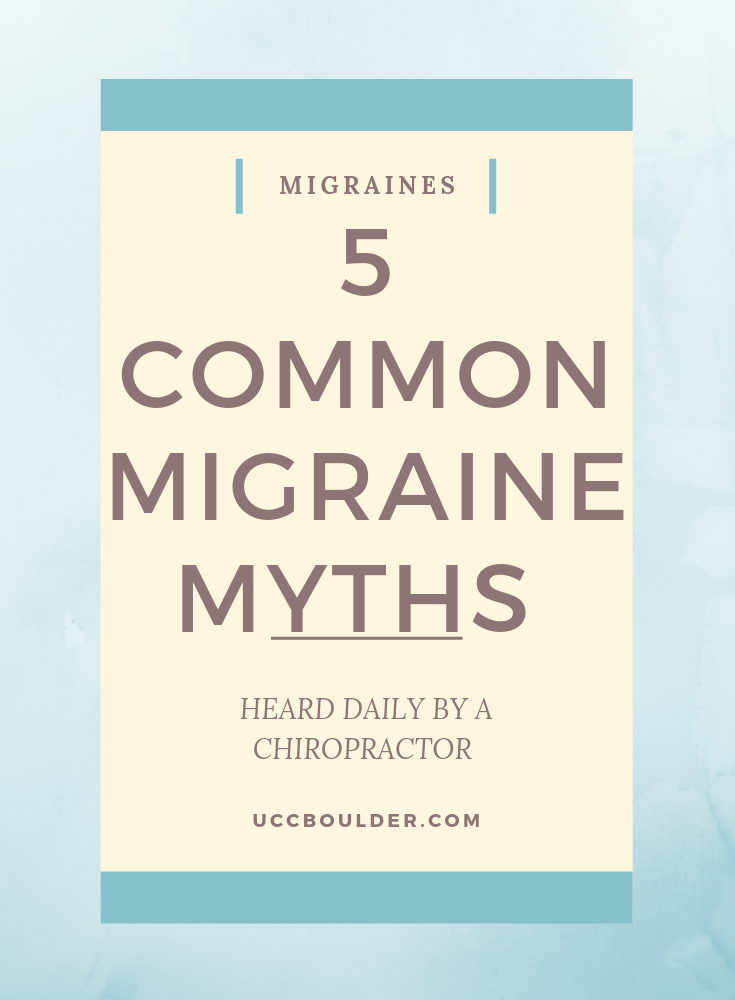Have you ever heard someone say “I have the worst migraine right now,” and then they canceled plans with you? Or maybe you have been that person?
Understanding migraines is one of the most important ways to develop empathy for people in your life who suffer from this condition.
Or maybe you are experiencing symptoms that you think might be a migraine, but you’re not sure. Well, this post is also for you!

If we have not met yet, it’s probably important for you to know that I’m an Upper Cervical Chiropractor.
Migraines are one of the top concerns people come to seek treatment for in my office. Sometimes my patients are experiencing migraines and they do not even realize it. Sometimes, they think they are experiencing a migraine, but they are calling it migraines incorrectly.
Despite the fact that about 14% of adults, and 10% of children experience migraines, this neurological condition has a lot of misinformation floating around. So if you or someone you love experiences migraines, continue reading so you don’t fall victim to these 5 migraine myths.
[thrive_lead_lock id=’911′]Hidden Content[/thrive_lead_lock]
Migraine Myth #1: A Migraine Is Just A Really Bad Headache
Let me clear this one up first. A migraine is not just a very bad headache. This is probably the most understood migraine myth.
A headache is one symptom of a migraine.
Migraines are considered a neurological condition. That puts migraines in the same category as diseases like alzheimer’s, multiple sclerosis and ALS. Often times, people who experience migraines will experience other neurological symptoms, such as visual disturbances or auras, before their head pain ever begins.
In some cases, people experience a migraine attack that involves no head pain whatsoever (mind-blown).
Migraine Myth #2: It’s Only A Migraine If You Have An Aura
False! I hear in my office a lot, “I think I have migraines but I’m not sure if they are truly migraine because I do not get aura’s every time or at all.”
According to the American Migraine Association, only 25-30% of those who suffer from migraines also experience an aura. And of that 25-30%, an aura is not always accompanied with the migraine.
Meaning: it is possible for the same patient to be diagnosed with both ‘migraine with aura’ and ‘migraine without aura.’
Migraine without aura is known as the “common migraine.” The common migraine accounts for about 75% of all migraines. So actually its much more likely you will have a migraine attack that involves no aura at all.
You’ll typically hear visual auras described as spots that show up in the field of vision.
However, auras can experienced as more than just visual disturbances. An aura can include sensory, speech, or movement disturbances (mind-blown again!).
Migraine Myth #3: Using Caffeine As A Cure/Trigger For Migraines
I’m sure you’ve heard: “too much caffeine can trigger a migraine.”
But also I’m sure you’ve heard someone say “if I don’t drink my caffeine I could get a migraine.”
Well which is it? Should you drink caffeine or should you cut it out?
My conclusion in this matter is that this is a migraine myth for some people.
Caffeine can be tricky for those with migraines. If you have a caffeine dependency and you don’t get your daily dose, you could be flirting with trouble. Likewise, if you pound back too many venti mocha lattes from Starbucks, that caffeine surge could trigger a migraine too.
This conundrum is why I believe this is a migraine myth… the notion that caffeine elimination or consumption used as a cure for migraines is not sustainable.
Drinking your daily caffeine will not guarantee you will remain migraine-free. Likewise, always avoiding caffeine will not guarantee you will remain migraine-free.
Some people actually use caffeine as temporary solution to migraines. If your migraine is related to blood flow to the brain being inhibited, then consuming caffeine can actually help you curb your symptoms from progressing while still in the prodrome phase. Keep an eye out for future posts about how using caffeine temporarily can curb a migraine during the prodrome phase.
[thrive_lead_lock id=’1024′]Hidden Content[/thrive_lead_lock]

Migraine Myth #4: I Can Cure Or Manage Migraines With Diet Or Avoiding Triggers
Most people have a good idea what their migraine triggers are. Maybe you only have migraines when you’re on your period, or maybe just when you eat gluten?
I want you to consider this: many women have their period every month and don’t get a migraine? How many people eat massive amounts of gluten and remain migraine-free. How many people have a stressful day at work followed by 4 hours of sleep…and wake up the next day migraine free?
Not fair right?!
Here’s the thing: you can reduce the frequency of attacks by avoiding things that you have a sensitivity to. However there is no cure-all-diet of migraines. I don’t know about you but I don’t think its very reasonable to live in a perfect bubble free of stressors to never trigger a migraine.
So the bigger question is, what’s happening within your body that doesn’t allow your body to process life’s stressors? Why can some people tolerate birthday cake full of gluten, but you live in fear that one bite of the wrong food could result in spending the rest of your day laying in bed with a cold compress?
There’s something happening within your body that is not allowing these stressful elements to be processed properly. So the result…a migraine. Almost as if your body just short-circuits.
So…what could be the cause of your bodies inability to process through your triggers? This brings me to my last migraine myth.
Migraine Myth #5: My Neck Pain and Migraines Are Unrelated
The Migraine In America 2018 Survey surveyed 4,356 migraine sufferers, and 69% reported experiencing neck pain as part of a migraine symptom.
That’s nearly three quarters of those surveyed.
Three quarters of 4,356 people experienced pain somewhere in their neck as the migraine attack happened.
I’m not sure about you, but that sounds pretty clinically significant to me!
Related: Why Your Migraine And Neck Pain Are Likely Related
Wouldn’t you agree it’s at least worth a trip to someone that specializes in the neck to rule in or out anything in your spine that could be contributing to your migraines?
You might be wondering how your neck could result in your bodies inability to process triggers, therefore leading to a migraine?
The first thing would be to evaluate if there is misalignment in the upper cervical spine. A misalignment here can affect blood flow to the brain, which can lead to increased intracranial pressure.
Ever felt that “pounding” sensation during a migraine? This is your body struggling to push blood through to your brain.
A misalignment in this part of your neck also does not allow your brainstem to do it’s job. Your brainstem controls everything automatic in your body. It also has the job of processing information.
Remember in myth #4 how we questioned why your body cannot process migraine triggers?
If you take anything away from this, I hope it’s that you explore the connection of your cervical spine and your migraines.
Chiropractors are the only type of physician trained to evaluate significant misalignments in the spine. An Upper Cervical Chiropractor has taken extra time and training to evaluate the neck, and are ideal for people experiencing a neurological condition.
[thrive_lead_lock id=’1024′]Hidden Content[/thrive_lead_lock]
So let’s recap.
Migraine Myth #1: A Migraine Is Just A Really Bad Headache
- Head pain is just one symptom of a migraine
- Other migraine symptoms include: auras, light and sound sensitivity, nausea or vomiting, numbness or tingling in the extremities.
Migraine Myth #2: It’s Only A Migraine If You Have An Aura
- 75% of all migraines are common migraines. Common migraines do not have an aura.
- Not all auras are visual. A migraine aura can be: sensory, speech, or movement disturbances.
Migraine Myth #3: Using Caffeine As A Cure/Trigger For Migraines
- Consuming caffeine in order to prevent a migraine is not sustainable.
- Avoiding caffeine in order to prevent a migraine is not sustainable.
Migraine Myth #4: I Can Cure Or Manage Migraines With Diet Or Avoiding Triggers
- Millions of people eat migraine trigger foods each day and have no migraines.
- Millions of women have a monthly period, and do not get a migraine.
Migraine Myth #5: My Neck Pain and Migraines Are Unrelated
- A clinically significant number of people experience neck pain in tandem with migraines. This is no coincidence.
- Disturbances to the alignment of the bones in your neck can lead to physiological processes that disrupt blood flow to the head.
- Disturbances to the alignment of the bones in your neck do not allow your body and brainstem to process stressors. In many cases, these stressors for you are your “migraine triggers.”
[thrive_lead_lock id=’911′]Hidden Content[/thrive_lead_lock]
If you’re in Boulder County, meet with me for a complimentary one-on-one consultation in our office if you’d like to talk more. You can always give our office a call at 303-900-7703 or send us an email at info@uccboulder.com. I’d love to connect!
Science Junky Research Sources
Source: Graham Headache Center, Brigham and Women’s Hospital, Harvard Medical School, Boston, MA, USA.
Title: The prevalence and burden of migraine and severe headache in the United States
Year: 2015
Link: https://www.ncbi.nlm.nih.gov/pubmed/25600719
Source: BMJ.
Title:Prevalence of Headache and Migraine in School Children
Year: 1994
Link: https://www.ncbi.nlm.nih.gov/pmc/articles/PMC2541010/
Source: American Migraine Association
Title: Migraine and Aura
Year: 2016
Link: https://americanmigrainefoundation.org/understanding-migraine/migraine-and-aura/
Source: American Headache Society
Title: Migraine in America Symptoms and Treatment (MAST) Study
Year: 2018
Link: https://www.ncbi.nlm.nih.gov/pubmed/30341895


